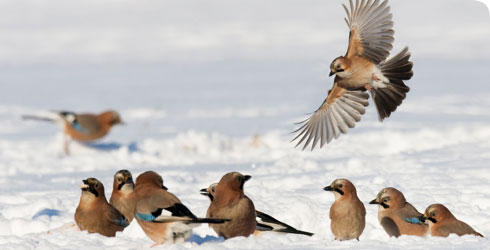Nesting and social behaviour
The jay nests mostly in trees or shrubs. Typical nest sites in Britain are:
- a main fork of a hawthorn or crab apple
- a clump of honeysuckle
- the forking branches near the summit of a birch sapling
- against the trunk of a birch or conifer, supported by outgrowing branches
They are built usually from 3 to 6 metres above the ground.
Both sexes build at all stages of the nest, each putting in place the material it has brought. The male tends to take the initiative in nest site selection. The nest is made of twigs, small sticks, and sometimes woody stems, with an inner lining of fine roots or root like fibres. Sometimes a little horsehair or any other fine wiry materials are used as well for the lining.
The eggs, usually 4 to 6, are light bluish green to dull light yellowish green, with speckles and small flecks of light brown or greenish brown. These markings are usually so dense that they partly obscure the ground colour.
The eggs are laid daily, in the early morning. The female may roost on the nest the night before laying the first egg but does not always do so. Incubation and brooding is done by the female only. However, some males will cover young for short periods.
The incubation period is 16 to 18 days. True incubation appears usually to begin with the second or third egg.
The sitting female is fed by the male who brings food in his gullet. Female leaves nest about once in three hours, for periods of 5 to 15 minutes.
After the young are hatched the female eats the hatched eggshells. Both sexes feed the young, at first mostly with food brought by the male. The young jays leave the nest at about 21 to 23 days, but will jump out as early as 17 days if badly frightened. When the young are fledged they appear to be recognized as individuals. A parent will often give some food to a young one then leave it, still begging eagerly, in order to seek out and feed another of the brood. The flying young appear to start following the parents at the stage when the latter begin to neglect them.
Young that have recently left the nest may rest or sleep in contact but adults maintain an individual distance of, usually, a metre or so. Even the members of a pair seldom come to within about a metre of each other without showing appeasing or threatening behaviour. The preludes to courtship feeding and copulation fall, of course, within these categories.
Only one brood is reared a year but repeat attempts are often made if eggs or young are destroyed. The eggs are usually laid in late April and the first half of May but quite often in late May and early June as well. The later nests are probably often repeats after loss of the first clutch, and the occasional clutches laid in mid or late June almost certainly are. Carrion crows Corvus corone and Magpies Pica pica are known at times to take eggs and young from jays’ nests and the Tawny owl Strix aluco sometimes catches incubating jays at night.
The typical ‘play’ or ‘frolicking’ of the jay consists of dashing from bough to bough within a rather small area, ducking, dodging and sometimes uttering low intensity variants of the grating call. It is seen most often in young jays among which it seems often infectious. The movements are those which are used in earnest when trying to escape from the attacks of a Goshawk Accipiter gentiles.
